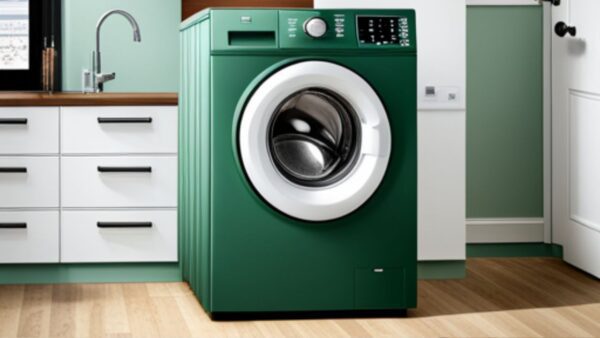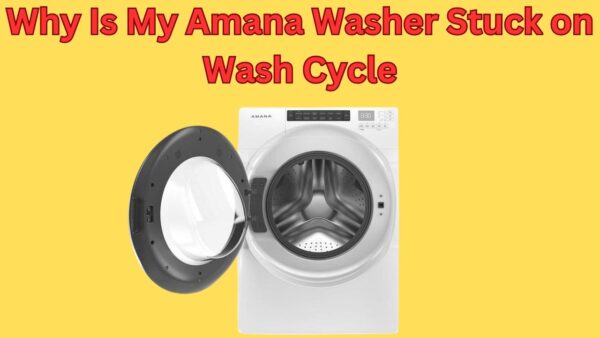Hello dear visitor welcome to our blog. If your Kenmore Washer Not Rinsing.
So Don’t worry about this common problem.
In this guide, we explain 15 common causes of these problems with outstanding fixes.
Kenmore Washer Not Rinsing

1. Faulty Water Inlet Valve
Cause
When you’re washing your favorite pair of jeans or your fluffy comforter, the water inlet valve is the gatekeeper that controls the flow of water into your washing machine.
If it’s faulty, it could be the reason why your Kenmore washer isn’t rinsing effectively.
A defective valve may not let in enough water, leading to a less-than-satisfactory rinse cycle or none at all!
Solution
Don’t sweat it; there’s a solution! First, check to see if the water inlet valve is indeed the culprit by examining it for any blockages or damage.
If it’s clear and still not working, then you’ll need to replace it. Remember, safety first! Always unplug your washing machine before starting any repair.
If you’re not comfortable doing it yourself, no worries, just holler at a professional.
They’ll have your machine up and running in no time. Don’t let a faulty water inlet valve keep you from a fresh rinse!
2. Blocked Drain Hose

Cause
If your Kenmore washer isn’t rinsing, there’s a good chance your drain hose might be blocked.
This usually happens when small items of clothing, lint, or debris get stuck in the hose, prohibiting the water from draining out of the machine.
Solution
No need to panic! You can tackle this issue on your own. First, turn off and unplug your washing machine for safety. Next, locate the drain hose – it’s typically located at the back.
Detach it carefully and check for any visible blockages. If you see any, use a long, flexible brush to remove the obstructions.
Finally, reattach the hose, plug your machine back in, and run a quick rinse cycle to see if the problem’s solved.
Remember: Always consult a professional if you’re unsure about any step in this process.
3. Timer Motor Malfunction
Cause
A faulty timer motor in your Kenmore washer could be the sneaky culprit behind your clothes not getting properly rinsed.
The timer motor is that cool little guy who controls the cycle and sequence of your washer.
If it’s malfunctioning, it may cut off the rinse cycle too soon or not initiate it at all!
An easy way to tell if the timer motor is slacking off is if your washer doesn’t move to the next cycle automatically.
Solution
If the timer motor is the bad guy, you’re going to need to replace it. But no worries! It’s not as scary as it sounds.
You can order a new timer motor online or from your local appliance parts store (make sure it’s the right one for your model!).
Then, with a little bit of patience and a few basic tools, you can install it yourself.
Just remember to turn off and unplug your washer before you start. Safety first, right? If you’re not super confident about DIY fixes, don’t hesitate to call in a professional.
Bottom line: you don’t have to live with a washer that doesn’t rinse. A timer motor replacement could be the quick fix you need!
4. Damaged Lid Switch
Cause
Whoa, a damaged lid switch can totally be a party pooper! It’s one of the main reasons your Kenmore washer might not be rinsing.
Basically, the lid switch signals the washer to start when the lid is closed. If it’s damaged, the washer might think the lid is open and refuse to rinse.
Remember, an uncooperative washer could be a sign of a rebellious lid switch!
Solution
No worries, we’ve got this! If the lid switch is the culprit, you’ll need to replace it. You might want to call in the pros for this, especially if you’re new to the DIY game.
But if you’re feeling adventurous, you can totally do it yourself — just make sure you’ve got the right replacement parts and tools.
Always remember, safety first! Double-check that everything is unplugged before you start messing with the circuits.
5. Impaired Water Level Control
Cause
Hey there, if your washer isn’t rinsing properly, one reason could be a wonky water level control.
It’s like the brain of your washing machine, telling it how much water to use for different loads.
If it gets messed up, your washer might be filling up too much or too little, leading to a less-than-stellar rinse.
Remember, the water level control is crucial for the proper functioning of your washer. If it’s not working right, your clothes might not be getting the runs they need.
Solution
Don’t sweat it, though! You can fix this. Start by checking the water level control, which is usually located behind the control panel.
If you see any damage, it might be time for a replacement. And if DIY isn’t your thing, don’t hesitate to call a professional. They’ll have your washer up and running in no time.
Whether you’re a do-it-yourself champ or prefer professional help, don’t put off fixing this issue.
A functioning water level control is key to a rinsing cycle that really gets your clothes clean!
6. Broken Drive Belt
Cause
The drive belt is like the unsung hero of your Kenmore washer – it’s what keeps the tub moving and your clothes getting clean!
When this sneaky little component breaks or wears out, your washer might stop rinsing effectively.
Signs of a broken drive belt can be an unusual noise during the wash cycle, or the tub simply not spinning.
Watch out for these symptoms – they usually mean a belt issue!
Solution
Don’t stress out, though! Fixing a broken drive belt is totally manageable.
You’ll need to get a new belt from a trusted supplier, so make sure it’s the right one for your model of washer.
Once you’ve got that in hand, you can usually replace the belt yourself by removing the back panel of the washer, but if you’re not comfortable with that, there’s no shame in calling in a professional.
Remember, safety first! If you’re unsure about doing this yourself, just call in the pros!
7. Unresponsive Pressure Switch
Cause
An unresponsive pressure switch in your Kenmore washer could be the villain behind your laundry still being soapy after a wash cycle.
This switch sends signals to the washer about when it’s time to rinse based on the water level in the tub.
If it’s malfunctioning, your washer might get the wrong message and skip the rinse cycle altogether.
The main symptoms of a faulty pressure switch are excessive suds or clothes that aren’t properly rinsed.
Solution
Fixing an unresponsive pressure switch is a task that may require professional assistance.
However, if you’re up for some DIY, you can try resetting the switch or cleaning the pressure hose since debris can often cause blockages. If that doesn’t work, the switch itself may need to be replaced.
Remember, if you’re unsure, it’s always safer to call in a professional repair service. Disassembling your washer without proper knowledge could lead to more serious problems.
8. Obstructed Filter Screen
Cause
When your clothes aren’t getting all sudsy clean, an obstructed filter screen could be your sneaky little culprit.
It’s like the goalkeeper of your washer, stopping particles and debris from messing up your rinse cycle.
When it gets all clogged up, it’s a major bummer, and your clothes might come out looking a bit grubby.
Solution
Fear not, my friend, because there’s a solution! Roll up those sleeves and prepare to get your hands dirty.
You’ll need to get in there and clean out any gunk that’s blocking the filter screen. If it’s super gnarly and beyond saving, you might need to get a new filter.
But remember, keep it clean, and you’ll have your clothes swishing and swashing their way to cleanliness in no time!
Oh, and don’t forget to routinely check your filter screen to avoid future blockages. It’s like a regular health check for your washer!
9. Defective Motor Coupler
Cause
The motor coupler is like the heart and soul of any washer, it’s the unsung hero that keeps things spinning.
If your Kenmore’s not rinsing, a defective motor coupler might be the party pooper. Its job is to transfer power from the motor to the transmission, enabling the agitation and spin cycles.
But hey, even heroes have off days. This little guy might wear out, break, or fail, causing a disruption in the power transfer which could lead to your washer not rinsing properly.
Solution
No worries, fixing a defective motor coupler isn’t rocket science. You’ll need to unplug your washer, disconnect the hoses (yeah, it might get a bit wet), and lay the machine on its front to access the motor coupler. Inspect it for any signs of wear or breakage. If it’s looking a little worse for wear, it’s time to replace it.
Replacement kits are readily available and often come with easy-to-follow instructions.
But if DIY isn’t really your thing, calling in a professional is a great option. Repair costs will vary, but it’s generally a pretty affordable fix.
Now, let’s get that washer back to its rinsey-spinny self.
10. Inefficient Pump
Cause
An inefficient pump is like ordering a smoothie and getting a cup of whole fruit instead – it just doesn’t do the job properly!
Your washer’s pump is responsible for shooting water out during the rinse cycle, but if it’s not doing its thing correctly, your clothes might not get the rinse they deserve.
The cause can range from a clog in the pump to the pump being worn out.
Major causes include clogged pumps and worn-out pump parts.
Solution
Now, let’s get your washer’s pump back in game shape! If the pump is clogged, a good cleaning should do the trick.
If the pump is worn out, though, it might have to be replaced. Don’t sweat it – either way, it’s a fix that can be managed with a bit of elbow grease or the help of a handy friend or professional.
Cleaning or replacing the pump are common solution to this issue.
11. Clogged Coin Trap
Cause
Hey there! So, you’ve got a clogged coin trap in your Kenmore Washer, huh? This usually happens when coins, small items, or even excessive lint get trapped — hence the name.
Think of it as your washer’s little treasure chest that’s doing its job a bit too well. When it’s clogged, it can prevent the washer from rinsing effectively.
Warning sign: If your clothes are coming out with a soapy feel or there’s water left in the drum, you might be dealing with a clogged coin trap.
Solution
Don’t panic! Unclogging a coin trap is pretty straightforward. First, turn off and unplug your washer — safety first, right?
Locate the coin trap (often found near the water pump at the bottom of the machine). Use a screwdriver to open it and clean out any objects or lint.
Once it’s all clear, put everything back together, plug in the washer, and give it a test run.
Remember: Regularly checking and cleaning the coin trap can prevent future clogs. It’s a small task that can make a huge difference!
12. Worn Out Clutch
Cause
A worn-out clutch can be a sneaky culprit behind your Kenmore washer not rinsing properly. It’s like the old trusty bike you once had that suddenly can’t switch gears.
The clutch assembly in your washer helps the tub to gradually gain its maximum spin speed.
As with any other part, the clutch can wear out over time, and if it does, it may cause the washer to stop spinning or rinsing.
The key point to remember: A problematic clutch can prevent the washer from spinning or rinsing.
Solution
Luckily, replacing the clutch isn’t rocket science! You may even be able to do it yourself if you’re handy.
The clutch is usually located underneath the washer, so you’ll need to tip the machine carefully to gain access.
It’s a good idea to check out a few online tutorials or consult your washer’s manual before diving in. If DIY isn’t your thing, there’s no harm in calling a professional.
Takeaway: Clutch replacement isn’t too complex. DIY or calling a pro, either way, you can get your washer up and running again!
13. Faulty Load Size Selector
Cause
The Load Size Selector, the cool little dial that lets you pick how much water your washer uses, can sometimes get a little rebellious and stop working.
This can cause your Kenmore washer to either use too much or too little water, resulting in your clothes not being rinsed properly.
Solution
The good news is that fixing the Load Size Selector is usually a pretty easy repair. You’ll need to replace the selector switch, which you can usually find online or at an appliance parts store.
Here’s a quick how-to: Unplug the washer, remove the control panel, disconnect the wiring, replace the switch, and reconnect everything.
Then give it a test run with a small load to make sure the problem is solved. Please remember that if you’re not comfortable doing this yourself, it’s always a good idea to call a professional.
14. Damaged Transmission
Cause
Oh no, a damaged transmission? That’s a bummer! You see, your washer’s transmission is like its brain, controlling the spinning, agitating, and rinsing cycles.
If it’s damaged, it could prevent your washer from properly rinsing your clothes. A broken transmission means your washer can’t correctly move through its cycles.
Solution
Don’t panic, though! No monster problem is without a solution. Depending on the severity of the damage, you might be able to repair the transmission.
But in more extreme cases, you might need to replace it entirely. It’s always best to consult with a washing machine repair professional.
They can diagnose the problem accurately and fix it in no time. Trust us; it’s not worth the headache of trying to DIY this one. Your best bet is to call in the pros for help.
15. Inadequate Water Supply
Cause
The primary reason your Kenmore washer may not be rinsing properly could be due to an insufficient water supply.
This can occur when the hoses connected to your washing machine are kinked or blocked, limiting the amount of water that can reach the machine.
Inadequate water supply could also be the result of clogged filters or a faulty water inlet valve.
Solution
Getting back to a flawless rinse cycle is straightforward. Start by checking all hoses for any visible signs of kinking or blockage and rectifying if needed.
For a clogged filter, simply remove and clean it. If the problem persists, you might be dealing with a faulty water inlet valve, which will need to be replaced.
Remember, it’s always okay to seek professional help if you’re unsure or uncomfortable performing these tasks yourself.
Conclusion
So, there we have it! You’ve been riding along on this journey of washer not rinsing dilemmas and we’ve navigated the choppy waters of troubleshooting together.
No need to freak out if your Kenmore washer has decided to go rogue.
Remember, it could just be a simple issue of overloading, or using too much detergent, or maybe it’s time to roll up those sleeves and check the drain hose or inner wash drum.
But hey, if it seems like you’re facing the washer equivalent of Everest, it’s totally cool to call in the experts.
After all, they’ve got the skills and the tools to get your washer back on track and your threads rinsed perfectly!
FAQs
Why is my washing machine not rinsing?
Your washer might not be rinsing because it’s unable to drain the water properly, often due to a clog or kink in the drain hose.
Why does my Kenmore washer stop on the rinse cycle?
Your Kenmore washer may stop on the rinse cycle if there’s a problem with the lid switch or the motor, preventing it from completing the cycle.
How do you fix a Kenmore washer that won’t drain or spin?
You can typically fix a Kenmore washer that won’t drain or spin by checking and clearing any blockages in the drain hose or replacing a faulty lid switch.
Kenmore Washing Machine Not Draining
Kenmore Washing Machine Door Lock
Kenmore Washing Machine Leaking Water
Kenmore Dryer Keeps Shutting Off
Kenmore Washer Sensing Light Flashing
Kenmore Washing Machine Leaking From the Bottom
Kenmore Washing Machine Not Locking
Kenmore Washer Lid Lock Flashing
Kenmore washer stuck on wash cycle
Kenmore Washing Machine Not Agitating
Washing Machine Making Buzzing Noise When Spinning

Name: Joseph Title: Owner and Founder Website: myappliancegeek.com
Biographical Info:
Joseph, the creative mind and founder behind myappliancegeek.com is a distinguished expert in the field of home appliances and technology.
Education: Joseph holds a prestigious degree in Appliance Engineering from a renowned institution in the United States, [Stanford University], where he gained a profound understanding of appliance design, mechanics, and technology.
Professional Experience: Joseph’s professional journey spans over [18 ] years in the home appliance industry. His extensive experience includes working with industry-leading appliance manufacturers, prominent retailers, and appliance repair services.
Entrepreneurship: In [2000], Joseph founded myappliancegeek.com, a platform dedicated to providing comprehensive information, advice, and solutions for those seeking guidance in the world of appliances.
Passion for Appliances: Joseph’s unwavering passion for home appliances stems from his belief in their pivotal role in improving our quality of life.
Contributions to the Industry: Joseph’s commitment to the home appliance industry is evident through his extensive writing and speaking engagements.
Community Involvement: Joseph is not only an online presence but also an active member of the community, frequently engaging in outreach programs, local workshops, and charitable initiatives.


